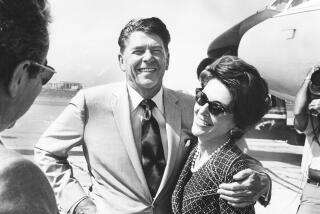Hocus-Pocus on High
We have wondered from time to time who was calling the shots at the Reagan White House. But we never suspected that it was San Francisco socialite-turned-astrologer Joan Quigley. And yet, according to White House Chief of Staff Donald T. Regan, First Lady Nancy Reagan was so obsessed with stargazing that âvirtually every major move and decision the Reagans madeâ was cleared with her astrologer to âmake certain that the planets were in a favorable alignment for the enterprise.â
Granted, Regan is not what weâd call an unimpeachable source. He clearly carries a grudge against Mrs. Reagan, who engineered his dismissal 14 months ago because she thought that heâd failed to shield her husband during the Iran-Contra scandal. And his complaints against her and the âshadowy distaff presidencyâ reek of misogyny as well as revenge. But, even taking into account the possibility of exaggeration, the picture that Regan paints of a President whose schedule was dictated by his horoscope, who was not allowed to leave the White House on inauspicious days, is profoundly disturbing.
The White House, trying to minimize the political effect of Reganâs memoirs, insists that the First Lady consulted Quigley only on matters of timing, not substantive policy. We donât buy that distinction. Timing often affects policy: If the President wonât make a speech or hold a press conference because his wife has decreed that the planets are not properly aligned, it may mean that opportunities are lost to influence the votes of legislators, the minds of the people, the positions of other governments. Regan, citing one example, notes that the President was âalmost immobileâ in early 1987, when the furor over Iran-Contra was at its peak, because Quigley had warned that he shouldnât venture far from home.
This hocus-pocus was even interjected into superpower politics. Before the 1985 summit meeting in Geneva, Mrs. Reagan called on her astrologer ânot only to choose auspicious moments for meetings between the two most powerful men on Earth but also to draw up horoscopes that presumably provided clues to the character and probable behaviorâ of Soviet leader Mikhail S. Gorbachev, Regan reports. That sounds like substance to us, and it raises tantalizing questions: Did the Soviets reciprocate by drawing up Reaganâs chart? Does Raisa Gorbachev consult other-worldly sources of information? And, on the eve of the Moscow summit meeting, what in the world does the Kremlin make of all this?
More to Read
Get the L.A. Times Politics newsletter
Deeply reported insights into legislation, politics and policy from Sacramento, Washington and beyond. In your inbox three times per week.
You may occasionally receive promotional content from the Los Angeles Times.









